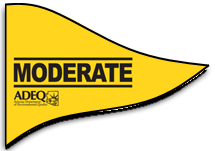AQD | Tucson Forecast

Updated On: 7/26/2024 - 7:19 AM
Click on each day to view forecast.
Friday Forecast:
Alert: Ozone High Pollution Advisory in effect for Friday |
Health Impacts >
Ozone
101 AQI
Max 8-hr Avg: 71 ppb
Max 8-hr Avg: 71 ppb
PM10
13 AQI
24-hr Avg: 14 µg/m3
24-hr Avg: 14 µg/m3
PM2.5
52 AQI
24-hr Avg: 9.7 µg/m3
24-hr Avg: 9.7 µg/m3
Saturday Forecast:
Ozone
90 AQI
Max 8-hr Avg: 67 ppb
Max 8-hr Avg: 67 ppb
PM10
10 AQI
24-hr Avg: 11 µg/m3
24-hr Avg: 11 µg/m3
PM2.5
50 AQI
24-hr Avg: 9.0 µg/m3
24-hr Avg: 9.0 µg/m3
Sunday Forecast:
Ozone
97 AQI
Max 8-hr Avg: 69 ppb
Max 8-hr Avg: 69 ppb
PM10
15 AQI
24-hr Avg: 16 µg/m3
24-hr Avg: 16 µg/m3
PM2.5
44 AQI
24-hr Avg: 8.0 µg/m3
24-hr Avg: 8.0 µg/m3
Monday Forecast:
Ozone
90 AQI
Max 8-hr Avg: 67 ppb
Max 8-hr Avg: 67 ppb
PM10
19 AQI
24-hr Avg: 20 µg/m3
24-hr Avg: 20 µg/m3
PM2.5
51 AQI
24-hr Avg: 9.2 µg/m3
24-hr Avg: 9.2 µg/m3
Tuesday Forecast:
Ozone
84 AQI
Max 8-hr Avg: 65 ppb
Max 8-hr Avg: 65 ppb
PM10
19 AQI
24-hr Avg: 21 µg/m3
24-hr Avg: 21 µg/m3
PM2.5
51 AQI
24-hr Avg: 9.1 µg/m3
24-hr Avg: 9.1 µg/m3
Air Quality By Pollutant:
Pollutant
Friday
7/26/2024
7/26/2024
Saturday
7/27/2024
7/27/2024
Sunday
7/28/2024
7/28/2024
Monday
7/29/2024
7/29/2024
Tuesday
7/30/2024
7/30/2024
O3
101
90
97
90
84
PM10
13
10
15
19
19
PM2.5
52
50
44
51
51
Pollutant
FRI
SAT
SUN
MON
TUE
O3
101
90
97
90
84
PM10
13
10
15
19
19
PM2.5
52
50
44
51
51
O3 = Ozone, PM10 = Particles ≤ 10 microns, PM2.5 = Particles ≤ 2.5 microns
Forecast Discussion:
An Ozone High Pollution Advisory is in effect for the Tucson metro area today.
Active weather last night helped to lower particulate matter concentrations this morning. With more storm activity expected tonight, we expect PM10 (dust) to remain well within the Good AQI category going forward. PM2.5 (smoke) levels will hover around the Good/Moderate AQI threshold during that same timeframe.
As for ozone, levels are forecast to remain relatively elevated through the weekend, but dropping slightly as an upper level wind shift and increased cloud cover will help to lower concentrations. We will continue to monitor wildfire smoke that has affected a few of our ozone sites this past week.
Have a great weekend!
- B. Droppleman
ADEQ Meteorologist
Active weather last night helped to lower particulate matter concentrations this morning. With more storm activity expected tonight, we expect PM10 (dust) to remain well within the Good AQI category going forward. PM2.5 (smoke) levels will hover around the Good/Moderate AQI threshold during that same timeframe.
As for ozone, levels are forecast to remain relatively elevated through the weekend, but dropping slightly as an upper level wind shift and increased cloud cover will help to lower concentrations. We will continue to monitor wildfire smoke that has affected a few of our ozone sites this past week.
Have a great weekend!
- B. Droppleman
ADEQ Meteorologist
What Flag Should I Fly?
Friday: Orange

|
Saturday: Yellow

|
|---|
Ozone and Your Health
People most vulnerable to the impacts of air pollution include children, older adults, adults exercising outdoors, people with heart or lung disease, and those suffering from asthma and bronchitis. Exposure to ozone can increase the number and severity of asthma attacks, cause or aggravate bronchitis or other lung disease, and reduce the body's ability to fight infection. Symptoms may include itchy eyes, nose and throat, wheezing, coughing, shortness of breath, chest pain, and upper respiratory issues | View Ozone Fact Sheet >
Please help reduce ozone by doing one or more of the following:
- Drive as little as possible, carpool, use public transit or telecommute
- Re-fuel your vehicle in the evening
- Avoid waiting in long drive-thru lines, if possible
- Use low-VOC (Volatile Organic Compounds) or water-based paints, stains, finishes and paint strippers - delay big painting projects
- Make sure containers of household cleaners, garage and yard chemicals, and other solvents are sealed properly to prevent vapors from evaporating into the air
